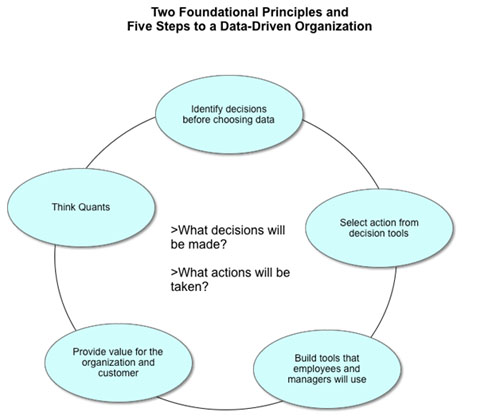Big Data is all the rage, but how should we use it, and how does it relate to process improvement and BPM?
Big Data is really just a new category of data, but one that has gotten a lot of buzz because it
- is a catchy term
- casts a wider net – out to external customers, potential buyers, suppliers, other networks in the general market place
- requires more sophisticated methods of gathering, modeling, and analyzing the data
So add Big Data to your organizational tools, but make it an integral part of a data-driven organization.
Foundational Principles
The two critical underlying questions before any organization starts gathering Big Data or data of any kind is:
- What decisions are we going to make with this data?
- What action are we going to take with this decision?
Use these foundational principles and the following five steps to build a successful data-driven organization.

1. Identify decisions before choosing data.
Did the organization just start with gathering data? How many finance departments and financial institutions have plenty of data, sometimes data overwhelm, but they don’t use most of it. What data should organizations gather for BPM? As organizations have moved to a more process-centered approach, they realized that most of the data currently being gathered was in the financial or personnel realm, not data about processes. So what additional data was needed for processes? That is the wrong question. Don’t start by gathering any data, start by asking what decisions will be made.
Here are a few examples of common decisions leaders or business process improvement teams make with data:
- How do we need to improve the current situation?
- What quantifiable goal should we set for improvements?
- Which of these five processes should be given priority?
- What is the cause of this upward or downward trend? How will we fix it?
Gather data about what customers or prospects think when you plan to act on these decision questions.
- What changes does the data say we should make? Which ones are we going to act upon?
- Which market segments should we address first?
- How would investing in this market segment impact our bottom line?
- Where could we invest to get more market share?
Gather data to monitor the changes made to the process if these decision questions will be used.
- Do we need to do anything more? What should be next?
- The changes impacted areas downstream. How shall we handle that?
The point is identify the decision the team or organization is going to make, and then choose the data to provide information for that decision.
2. Select action from decision tools.
If the data raises the right questions then the organization needs decision tools and decision structures to move into action/implementation—the second foundational principle. For example trend analysis may have upper and lower limits that call for action to add resources or do a root cause analysis. Or, analytical models can suggest workload optimization actions such as employee scheduling.
For the business process improvement (BPI) team, data gathering begins with getting baseline data and continues with finding wastes or challenges. Decisions made during the BPI project include (1) which are the key problems, (2) what is their root cause, and (3) what changes will be made to improve the process. The first action in the workplace may be some Quick Wins and the larger action is to make the recommended changes to the process.
Then the ‘new’ process is monitored for continuous improvement. Now the decisions are (1) is the process producing the expected outputs? (2) what is the customer response? (3) are the leading indicators suggesting problems? Probably the data being tracked is similar to the data for the original BPI project. Big Data trends may suggest decisions about the threat of competitive forces or the opportunities of new consumer needs. This data and the decisions call for actions to adjust, improve, or transform the process.
3. Build tools that employees and managers will use.
Once the organization is collecting data and making decisions, someone has to use it for the action part to happen. Action usually begins with frontline employees who do the core work. If the data is not accessible to employees they won’t use it; if the tools aren’t user friendly they won’t be inclined to use them; if the employees don’t have the authority to take the action, they won’t do anything. Tools also need to allow people doing the work to apply their own experience and judgment; e.g. doctors are more likely to use suggestions from diagnostic tools when they can apply their own judgment vs. feel compelled to follow strict guidelines.
Management needs to be encouraging employees—checking in with employees (the old management by walking around) to see what is happening, what the data is indicating and what they are doing. They need to have their own tools to decide and take action needed across the process or their department. Dashboards for daily monitoring can help point out concerns that need actions and regular meetings provide forums for dialog across processes and functions.
It makes sense to engage managers and employees early in suggesting requirements for choosing data to gather, selecting decision tools, and building the processes that will use them. It is also necessary later to provide them the training to use the tools, and then monitor early implementation to see what’s working and not, and make adjustments.
4. Provide value for the organization and the customer
Sometimes in business process management today IT makes the decision for what tools provide feedback on a process. With Big Data an analogous situation happens when data modelers and data scientists decide on the data and tools to be gathered and modeled.
A more effective approach happens when these ‘technical’ experts collaborate with the business to determine what is needed. Together they can decided what data and analysis will lead to action that provides value to the organization or the customer. For example:
- In hospitals, screening tools for disease conditions and severity can lead to faster disease management; this action provides value in (at least) two ways (1) lower mortality rates and (2) reduced costs from shorter length of hospital stay.
- In a financial institution, productivity analysis of individuals, teams, and workflow was used to do workload balancing, suggest best practices, and then train employees to a higher standard. These actions led to (1) faster cycle time and (2) increasing outputs per employee (lower costs with greater volumes).
5. THINK QUANTS
Big Data has caught the eye of senior management, but I think that a data-driven organization is everyone’s job. The first step is for everyone to THINK QUANTS at whatever level they work at. For the employee that means asking questions not just about why this happens, but first looking at the data to see how often this happens, under what conditions, at what time in the process, for what products or customer segments, etc. The supervisor and manager should be doing the same, but at their level of work. They might be asking about productivity, cycle time, or error categories. Senior management would be looking for data that measures key initiatives or strategies; they could also be using Big Data to look for trends across divisions, or that should be integrated enterprise wide. These data elements, analysis, and actions should be nested so that enterprise strategies drive the data that managers and supervisors are looking at and employees are following daily. That way everyone can talk to one another about the data –as the data is always moving in sync toward the ultimate business and customer value expected from the strategy.
But start small and be forgiving. Companies moving toward a process culture are used to financial and personnel measures. To start in BPM, get management and employees to define the baseline data category for a process improvement project and have the employees get the actual quantifiable baseline information. Have the business process improvement team gather data within the process to highlight key problems and gaps between the current situation and the improved future state. These are beginning data. If the metrics gets used and employees or managers suggest they are not the best metrics—Hooray! They were used and now the group can identify a ‘better’ metric and see if that reveals more of what is wanted. But get employees and managers asking about data, making decisions with data, talking across levels with data, setting regular meetings for data discussions and taking action. THINK QUANTS is how to begin a data-driven organization.

















